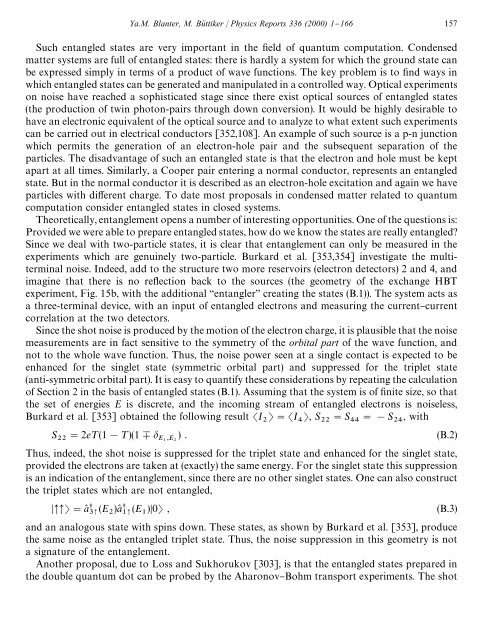shot noise in mesoscopic conductors - Low Temperature Laboratory
shot noise in mesoscopic conductors - Low Temperature Laboratory
shot noise in mesoscopic conductors - Low Temperature Laboratory
You also want an ePaper? Increase the reach of your titles
YUMPU automatically turns print PDFs into web optimized ePapers that Google loves.
Ya.M. Blanter, M. Bu( ttiker / Physics Reports 336 (2000) 1}166 157<br />
Such entangled states are very important <strong>in</strong> the "eld of quantum computation. Condensed<br />
matter systems are full of entangled states: there is hardly a system for which the ground state can<br />
be expressed simply <strong>in</strong> terms of a product of wave functions. The key problem is to "nd ways <strong>in</strong><br />
which entangled states can be generated and manipulated <strong>in</strong> a controlled way. Optical experiments<br />
on <strong>noise</strong> have reached a sophisticated stage s<strong>in</strong>ce there exist optical sources of entangled states<br />
(the production of tw<strong>in</strong> photon-pairs through down conversion). It would be highly desirable to<br />
have an electronic equivalent of the optical source and to analyze to what extent such experiments<br />
can be carried out <strong>in</strong> electrical <strong>conductors</strong> [352,108]. An example of such source is a p-n junction<br />
which permits the generation of an electron-hole pair and the subsequent separation of the<br />
particles. The disadvantage of such an entangled state is that the electron and hole must be kept<br />
apart at all times. Similarly, a Cooper pair enter<strong>in</strong>g a normal conductor, represents an entangled<br />
state. But <strong>in</strong> the normal conductor it is described as an electron-hole excitation and aga<strong>in</strong> we have<br />
particles with di!erent charge. To date most proposals <strong>in</strong> condensed matter related to quantum<br />
computation consider entangled states <strong>in</strong> closed systems.<br />
Theoretically, entanglement opens a number of <strong>in</strong>terest<strong>in</strong>g opportunities. One of the questions is:<br />
Provided we were able to prepare entangled states, how do we know the states are really entangled?<br />
S<strong>in</strong>ce we deal with two-particle states, it is clear that entanglement can only be measured <strong>in</strong> the<br />
experiments which are genu<strong>in</strong>ely two-particle. Burkard et al. [353,354] <strong>in</strong>vestigate the multiterm<strong>in</strong>al<br />
<strong>noise</strong>. Indeed, add to the structure two more reservoirs (electron detectors) 2 and 4, and<br />
imag<strong>in</strong>e that there is no re#ection back to the sources (the geometry of the exchange HBT<br />
experiment, Fig. 15b, with the additional `entanglera creat<strong>in</strong>g the states (B.1)). The system acts as<br />
a three-term<strong>in</strong>al device, with an <strong>in</strong>put of entangled electrons and measur<strong>in</strong>g the current}current<br />
correlation at the two detectors.<br />
S<strong>in</strong>ce the <strong>shot</strong> <strong>noise</strong> is produced by the motion of the electron charge, it is plausible that the <strong>noise</strong><br />
measurements are <strong>in</strong> fact sensitive to the symmetry of the orbital part of the wave function, and<br />
not to the whole wave function. Thus, the <strong>noise</strong> power seen at a s<strong>in</strong>gle contact is expected to be<br />
enhanced for the s<strong>in</strong>glet state (symmetric orbital part) and suppressed for the triplet state<br />
(anti-symmetric orbital part). It is easy to quantify these considerations by repeat<strong>in</strong>g the calculation<br />
of Section 2 <strong>in</strong> the basis of entangled states (B.1). Assum<strong>in</strong>g that the system is of "nite size, so that<br />
the set of energies E is discrete, and the <strong>in</strong>com<strong>in</strong>g stream of entangled electrons is <strong>noise</strong>less,<br />
Burkard et al. [353] obta<strong>in</strong>ed the follow<strong>in</strong>g result I "I , S "S "!S , with<br />
S "2e¹(1!¹)(1G ) . (B.2)<br />
Thus, <strong>in</strong>deed, the <strong>shot</strong> <strong>noise</strong> is suppressed for the triplet state and enhanced for the s<strong>in</strong>glet state,<br />
provided the electrons are taken at (exactly) the same energy. For the s<strong>in</strong>glet state this suppression<br />
is an <strong>in</strong>dication of the entanglement, s<strong>in</strong>ce there are no other s<strong>in</strong>glet states. One can also construct<br />
the triplet states which are not entangled,<br />
"a( t (E )a( t (E )0 , (B.3)<br />
and an analogous state with sp<strong>in</strong>s down. These states, as shown by Burkard et al. [353], produce<br />
the same <strong>noise</strong> as the entangled triplet state. Thus, the <strong>noise</strong> suppression <strong>in</strong> this geometry is not<br />
a signature of the entanglement.<br />
Another proposal, due to Loss and Sukhorukov [303], is that the entangled states prepared <strong>in</strong><br />
the double quantum dot can be probed by the Aharonov}Bohm transport experiments. The <strong>shot</strong>
















